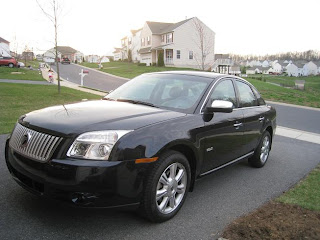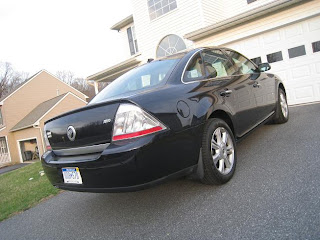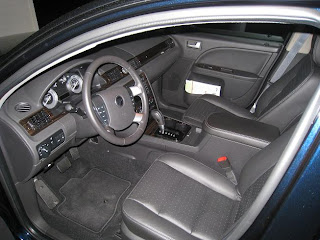2008 Mercury Sable Premier AWD Review
 Last week, Ford dropped off a 2008 Mercury Sable Premier AWD for me to evaluate. I had actually requested this car because so many people have told me over the past few years that the Taurus and Sable are good cars obscured by their pedestrian, overly inoffensive styling. The line on these cars (when they were still named Five Hundred and Montego) in the past had also been that they were underpowered (by a 3.0 liter V6 producing just over 200 horsepower) and their available CVT transaxles provided an unusual driving experience. The cars now come with an upgraded engine and transmission, and improved styling, but they still are not resonating with consumers.
Last week, Ford dropped off a 2008 Mercury Sable Premier AWD for me to evaluate. I had actually requested this car because so many people have told me over the past few years that the Taurus and Sable are good cars obscured by their pedestrian, overly inoffensive styling. The line on these cars (when they were still named Five Hundred and Montego) in the past had also been that they were underpowered (by a 3.0 liter V6 producing just over 200 horsepower) and their available CVT transaxles provided an unusual driving experience. The cars now come with an upgraded engine and transmission, and improved styling, but they still are not resonating with consumers.
Exterior
 When Ford decided that perhaps it wasn’t such a great idea to throw away the Taurus and Sable names after over 20 years in the marketplace, refreshing the Five Hundred and Montego seemed like the perfect opportunity to introduce the reborn names. To my eyes, the Sable’s new front clip is more attractive than the Taurus’ Fusion-like nose. The overall impression of this car, though, is one of size. It’s a very tall car – the rounded roofline does obscure some of its height, but it’s only a few inches shorter than many crossovers. My test car was a loaded Premier edition with all wheel drive; I’m not sure if it was the all wheel drive hardware or just the car’s fundamental engineering, but its ride height was a little high for my taste; the tops of the tires still left a several inch tall gap between them and the bottom of the fender’s wheel openings. The car is so substantial in size that I had assumed it had 16 inch or perhaps 17 inch wheels, but in fact it was equipped with 18 inch wheels and Pirelli tires.
When Ford decided that perhaps it wasn’t such a great idea to throw away the Taurus and Sable names after over 20 years in the marketplace, refreshing the Five Hundred and Montego seemed like the perfect opportunity to introduce the reborn names. To my eyes, the Sable’s new front clip is more attractive than the Taurus’ Fusion-like nose. The overall impression of this car, though, is one of size. It’s a very tall car – the rounded roofline does obscure some of its height, but it’s only a few inches shorter than many crossovers. My test car was a loaded Premier edition with all wheel drive; I’m not sure if it was the all wheel drive hardware or just the car’s fundamental engineering, but its ride height was a little high for my taste; the tops of the tires still left a several inch tall gap between them and the bottom of the fender’s wheel openings. The car is so substantial in size that I had assumed it had 16 inch or perhaps 17 inch wheels, but in fact it was equipped with 18 inch wheels and Pirelli tires.
Interior
 The first time I opened the door, I was really impressed by the Sable. The interior was, of course, spacious with ample legroom for both front and back seat passengers, and also had plenty of headroom, thanks to the high roofline. Materials had a quality feel; they were similar in quality to the $39,000 Lincoln MKZ that I reviewed a few weeks ago, although the Sable actually left me with more of an impression of luxury because it had ample fake wood instead of ample fake aluminum like the MKZ featured. The wood’s realism was actually reasonably convincing, thanks to its interesting darker hue and a lack of unlikely curvatures and shapes. Another nice detail was contrasting stitching on the steering wheel’s leather as well as on the seats and center console lid; the charcoal black (Mercury’s name – not mine) interior was somewhat monochromatic, but would have been more so were it not for the dark “wood” and white stitching.
The first time I opened the door, I was really impressed by the Sable. The interior was, of course, spacious with ample legroom for both front and back seat passengers, and also had plenty of headroom, thanks to the high roofline. Materials had a quality feel; they were similar in quality to the $39,000 Lincoln MKZ that I reviewed a few weeks ago, although the Sable actually left me with more of an impression of luxury because it had ample fake wood instead of ample fake aluminum like the MKZ featured. The wood’s realism was actually reasonably convincing, thanks to its interesting darker hue and a lack of unlikely curvatures and shapes. Another nice detail was contrasting stitching on the steering wheel’s leather as well as on the seats and center console lid; the charcoal black (Mercury’s name – not mine) interior was somewhat monochromatic, but would have been more so were it not for the dark “wood” and white stitching.
It was good to have another chance to use Ford’s exclusive SYNC system. As this Sable was equipped with a navigation system (a $1,995 option), it worked identically to the MKZ’s two weeks earlier. One complaint/observation that I had about the MKZ’s SYNC system still stands for the Sable; it does not remember playlists once the car has been turned off, although it will keep on the last song that you were playing. However, I wish every car had the excellent Bluetooth telephone connectivity that SYNC features; one thoughtful touch is that the number keypad is still active when the car is moving; Toyotas with navigation systems do not allow this and it can be very frustrating, but SYNC eliminates that frustration. After all, the workaround with the Toyota system is to dial the number on your handheld phone, then talk over Bluetooth once connected; it seems safer to enter a number on the navigation touchscreen rather than fumbling with your handheld phone when driving. I did yearn for the MKZ’s THX II Audiophile sound system; higher volumes – especially in songs with a lot of bass – tended to upset the speakers a bit. Although this Sable had the “Audiophile” system, it clearly wasn’t in the same class as the MKZ’s.
Parents of small children will be pleased to know that both a forward facing convertible car seat and a rear facing infant carrier fit in the back seat without any trouble. Further, the car’s spacious rear seat, large door openings, and high roofline all make getting little ones in and out about as easy as possible with a car (though a minivan with sliding doors is, of course, still easier). Looking at the two seats side-by-side, I believe that it would be difficult to fit a third child seat in the middle position when the outboard spots also have child seats installed.
The trunk is large enough for a folded stroller and left plenty of room for groceries or other cargo, and both the split rear seatback and the front passenger seatback folded flat to allow the driver to haul long items without the need to tie the trunk to the closed position.
The one odd sensation inside the Sable is the sound that the turn signals make. It didn’t bother me, per se, but was unlike any turn signal sound I’d heard before. They sounded like a horse was clip-clopping down a cobblestone street. Other sounds – aside from the growl of the engine under acceleration – were very subdued. Wind noise was not an issue, and I didn’t really have as much appreciation for how quiet the Sable was inside until I opened a window and realized how much sound it was blocking. I wouldn’t call the car remarkably quiet, but it was definitely peaceful.
Driving Experience
Although the Sable is a large car, it didn’t really feel like it, with the notable exception of navigating sharp curves within the parking garage near my office. In those tighter confines, I always felt very conscious of the car’s width. As with the MKZ, the 3.5 liter 263 horsepower V6 engine and six-speed automatic transaxle were a good pair, but torque management again severely restricted power from a stop. Additionally, shifts were extremely smooth – even under full throttle – because the engine computer cuts torque when shifting to smooth the transition between gears and preserve the drivetrain. The sensation is one of the car taking a moment to catch its breath between each gear. However, its target market probably appreciates the buttery-smooth shifting.
The steering ratio is slower than I’d prefer, but it seemed to be reasonably accurate. The Sable’s suspension was capable of soaking up any bumps that came its way, but driving briskly on a country road could quickly get the suspension to wallow a bit. Again, I’m not in this car’s target demographic, so that’s probably not a concern among buyers of traditional large cars. Plus, it felt a heck of a lot more buttoned-down than did the last Lincoln Town Car that I rented; many fans of the new Taurus and Sable point out that those cars are about the same size inside as the Town Car, but have the benefit of front wheel drive-based packaging and another few decades of development work that the Town Car didn’t enjoy. The Sable’s brakes brought the big girl to a stop without drama.
Fuel Economy
The Sable AWD is rated at 17 mpg city and 24 mpg on the highway. Because it’s a heavy car with the all wheel drive hardware, it burned a lot of fuel for me in stop and go traffic. Overall, I got about 16 miles per gallon, but when cruising at a steady speed on the highway at 70 miles per hour, a freshly-reset information screen showed figures in the mid- to upper-20s, right in line with EPA expectations. Although the Sable is a larger vehicle than the MKZ, it also got poorer fuel economy under my stewardship, driving a similar route and in similar traffic conditions. Front wheel drive models are rated at 18/24, so the additional all wheel drive hardware forces buyers to sacrifice about four miles per gallon on the highway for the security of all wheel drive. Similarly-sized vehicles such as the Pontiac G8 V6 (rated 17/25 for rear wheel drive) and Chrysler 300 V6 AWD (rated 15/22) can’t match the Sable’s fuel economy. V8 versions of those competitors get even worse fuel economy.
Pricing
The base price for a 2008 Sable is $24,375 (including destination) for a front wheel drive model. All wheel drive adds $1,850 to the price, and the Premier package (the only trim levels are base and Premier) adds a substantial $3,790, but includes 18 inch wheels, dual zone climate control, SYNC, and leather seats. Navigation, stability control, adjustable pedals, a reverse sensing system, a cargo management system, and Sirius satellite radio added another $3,375 to the tab, for a total MSRP (including destination) of $33,750. The Sable currently carries a $2,000 to $4,000rebate and dealers should be interested in cutting deals, as sales are down 12.4% year to date.
Bottom Line
The Sable was a heck of a good car. I was impressed by its large interior, five star safety ratings, and quality interior materials. The seats were comfortable and roomy, the car was easy to drive, and was pleasant to look at. It’s a shame the Sable started its rebirth behind the 8-ball a bit, because the Montego was so unsuccessful and many consumers are probably unaware of all of the significant improvements under the skin compared to a first-year Mercury Montego (primarily improved interior materials, the six-speed automatic, and 3.5 liter V6). However, taking the same fundamental package and wrapping it into a “Superman” wrapper instead of a “Homer Simpson” wrapper will probably help the next Sable substantially. Meanwhile, buyers astute enough to put it on their shopping lists will be impressed by this very credible effort from Mercury.




